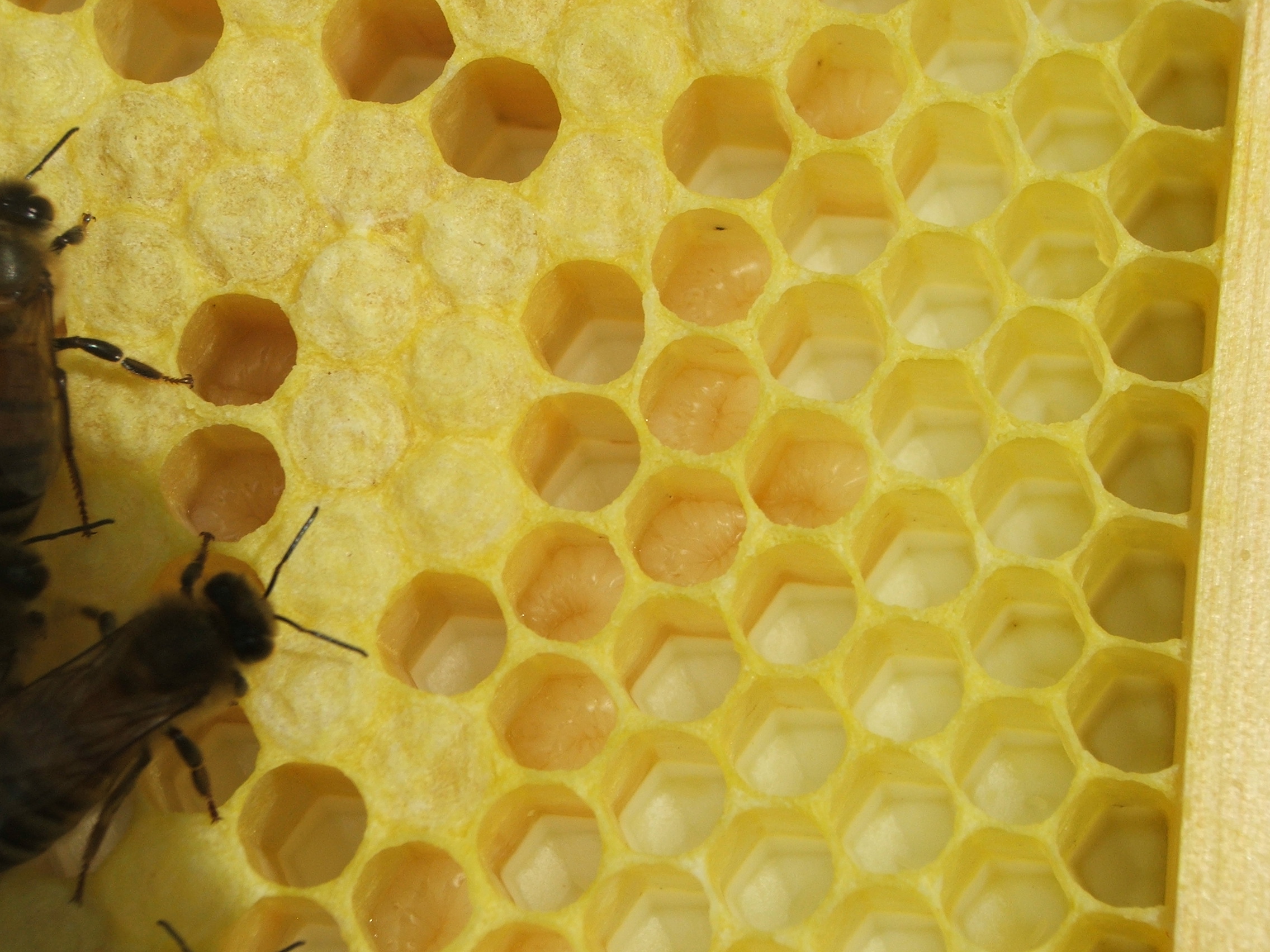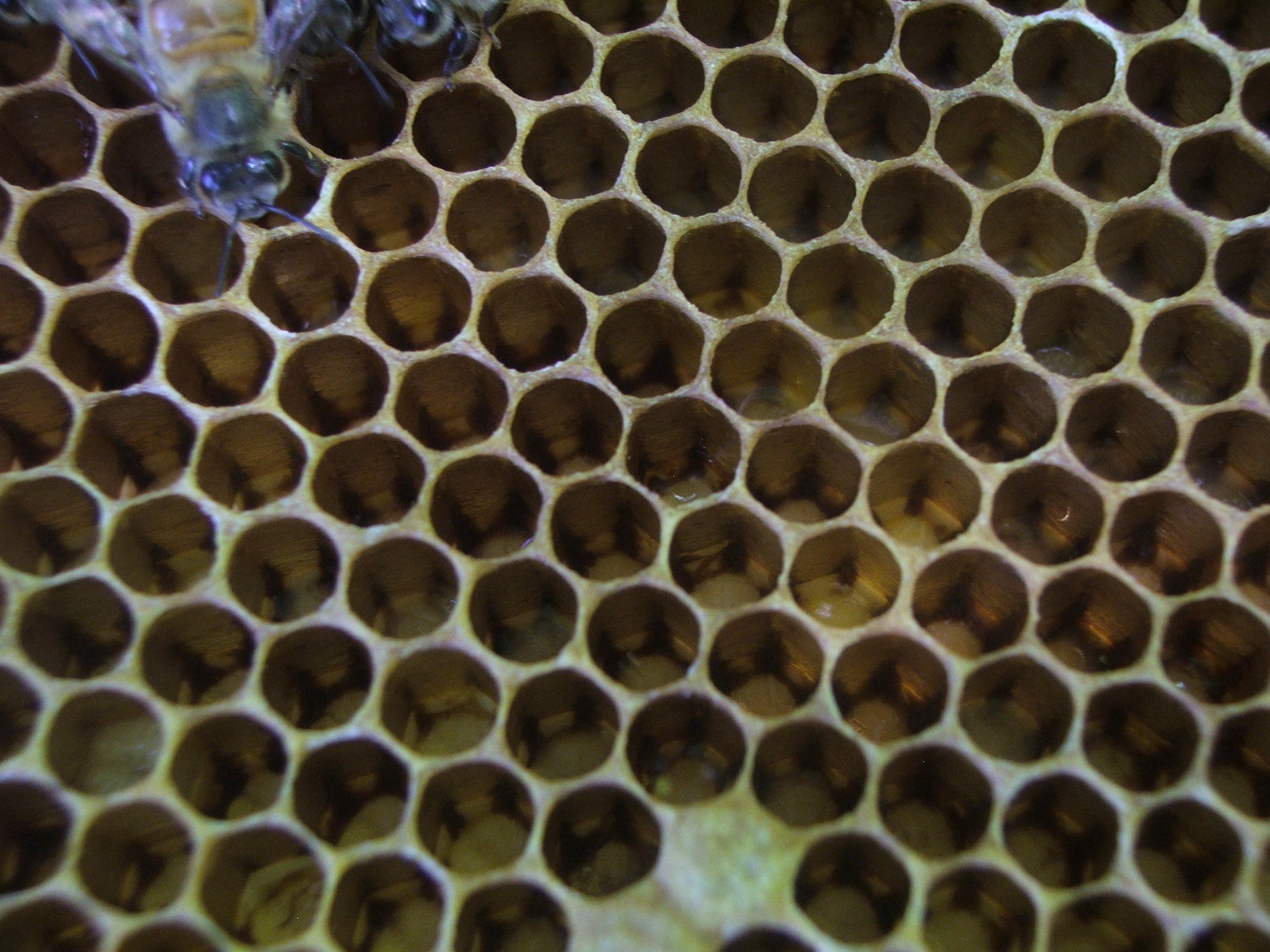brood comb on:
[Wikipedia]
[Google]
[Amazon]
 The brood comb is the
The brood comb is the
 Honeycomb and brood comb have two sides. The vertex where three cells meet on one side is in the center of a cell on the other side.
Freshly created beeswax comb may appear white at first. After the first generation of bees hatch from the brood comb it becomes yellow and darker in color (Comb that is exclusively used for honey comb appears lighter). Brood comb that is used for subsequent generations of bee brood becomes darker and darker until it almost appears black. The cocoon sticks to the hexagonal walls of the cell and is not removed. The change in broodcomb color is due to the cocoon that remains inside the cell and also small soil and
Honeycomb and brood comb have two sides. The vertex where three cells meet on one side is in the center of a cell on the other side.
Freshly created beeswax comb may appear white at first. After the first generation of bees hatch from the brood comb it becomes yellow and darker in color (Comb that is exclusively used for honey comb appears lighter). Brood comb that is used for subsequent generations of bee brood becomes darker and darker until it almost appears black. The cocoon sticks to the hexagonal walls of the cell and is not removed. The change in broodcomb color is due to the cocoon that remains inside the cell and also small soil and
beeswax
Bee hive wax complex
Beeswax (also known as cera alba) is a natural wax produced by honey bees of the genus ''Apis''. The wax is formed into scales by eight wax-producing glands in the abdominal segments of worker bees, which discard it in o ...
structure of cells where the queen bee
A queen bee is typically an adult, mated female ( gyne) that lives in a colony or hive of honey bees. With fully developed reproductive organs, the queen is usually the mother of most, if not all, of the bees in the beehive. Queens are develope ...
lays eggs. It is the part of the beehive where a new brood is raised by the colony. During the summer season, a typical queen may lay 1500-2000 eggs per day, which results in 1500-2000 bees hatching after the three-week development period.
The brood comb is usually found in the lower part of the beehive
A beehive is an enclosed structure which houses honey bees, subgenus '' Apis.'' Honey bees live in the beehive, raising their young and producing honey as part of their seasonal cycle. Though the word ''beehive'' is used to describe the nest of ...
, while the honeycomb
A honeycomb is a mass of Triangular prismatic honeycomb#Hexagonal prismatic honeycomb, hexagonal prismatic cells built from beeswax by honey bees in their beehive, nests to contain their brood (eggs, larvae, and pupae) and stores of honey and pol ...
may surround the brood area and is found exclusively in the honey super
A honey super is a part of a commercial or other human-managed beehive that is used to collect honey
Honey is a sweet and viscous substance made by several species of bees, the best-known of which are honey bees. Honey is made and stor ...
s. When a queen does not have enough brood comb to lay eggs, usually due to congestion from pollen or honey, the bee colony may be more prone to swarm.
Size
The hexagonal prismatic cells for the brood comb vary in size. The diameter ranges between less than to greater than . Drone bees require the largest cell size. There is some evidence that suggests that a smaller cell enables faster development time from egg to a fully developed, adult bee.Appearance
pollen
Pollen is a powdery substance produced by most types of flowers of seed plants for the purpose of sexual reproduction. It consists of pollen grains (highly reduced Gametophyte#Heterospory, microgametophytes), which produce male gametes (sperm ...
particles that are tracked in by the bees over time.
Queen cells
Queen bee
A queen bee is typically an adult, mated female ( gyne) that lives in a colony or hive of honey bees. With fully developed reproductive organs, the queen is usually the mother of most, if not all, of the bees in the beehive. Queens are develope ...
s are not raised in the hexagonal brood comb but require a special queen cell.
See also
*Swarming (honey bee)
Swarm behaviour, or swarming, is a collective behaviour exhibited by entities, particularly animals, of similar size which aggregate together, perhaps milling about the same spot or perhaps moving ''en masse'' or migrating in some direction. ...
References